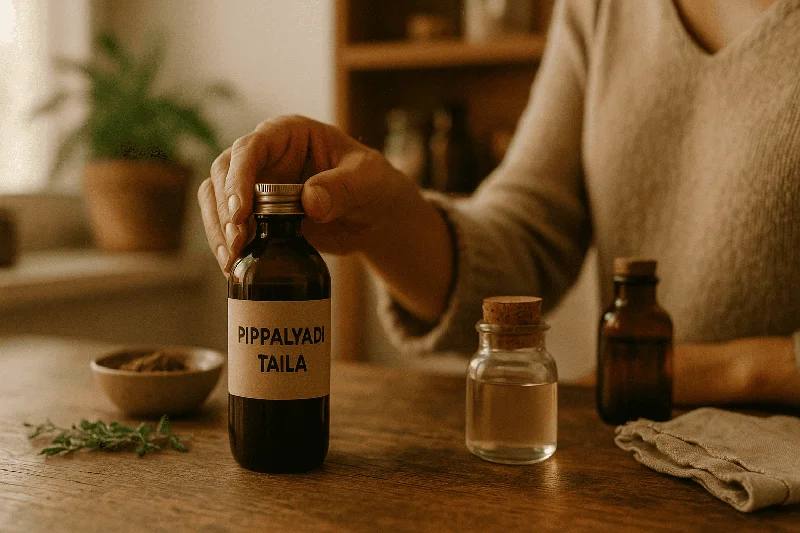Ask Ayurvedic doctor a question and get a consultation online on the problem of your concern in a free or paid mode. More than 2,000 experienced doctors work and wait for your questions on our site and help users to solve their health problems every day.
Shop Now in Our Store
Pippalyadi Taila – Ayurvedic Oil Benefits, Uses & Applications

Introduction to Pippalyadi Taila
Pippalyadi Taila is a traditional Ayurvedic medicated oil formulated with Pippali (Long Pepper) and other herbs. Renowned for its warming and therapeutic properties, this oil is used to alleviate various ailments ranging from joint pain to digestive issues. Rooted in classical Ayurvedic wisdom, Pippalyadi Taila supports balance among the doshas, eases discomfort, and enhances overall well-being through topical and sometimes internal applications.
Historical Roots & Ayurvedic Significance
In Ayurveda, oils (Taila) are highly valued for their ability to penetrate deep tissues and balance bodily energies. Pippalyadi Taila is mentioned in classical texts as a remedy that leverages the medicinal properties of Pippali and complementary herbs. Historically, Ayurvedic practitioners prepared this oil to address conditions involving Vata and Kapha imbalances, demonstrating its longstanding significance in managing pain, improving digestion, and promoting vitality.
Key Components & Therapeutic Benefits
1. Herbal Composition
Pippalyadi Taila is primarily composed of:
- Pippali (Piper longum): A warming herb known for its anti-inflammatory, carminative, and analgesic properties.
- Additional Herbs: Often includes ingredients like ginger, black pepper, or other spices that synergize with Pippali to enhance its effects.
- Base Oil: Typically sesame or coconut oil, which serves as a carrier and enhances absorption.
2. Dosha Balancing & Healing Properties
This oil helps to balance Vata and Kapha doshas due to its warming and penetrating qualities. The benefits include:
- Pain Relief: Soothes joint and muscle pain when used in massage.
- Digestive Support: When used in Abhyanga (therapeutic massage) over the abdomen, it can stimulate digestion and relieve bloating.
- Anti-Inflammatory Effects: Reduces inflammation, swelling, and stiffness in affected areas.
- Nervous System Relaxation: Provides calming effects that can ease stress and anxiety.
3. Applications of Pippalyadi Taila
- Massage Therapy: Regular Abhyanga using Pippalyadi Taila can relieve body aches, improve circulation, and calm the mind.
- Localized Treatment: Applied directly to sore joints or muscles to reduce pain and inflammation.
- Ayurvedic Therapies: Used as part of Panchakarma procedures for its detoxifying and rejuvenating properties.
How Pippalyadi Taila Works: The Science Behind the Approach
The active compounds in Pippali, such as piperine, enhance circulation and possess potent anti-inflammatory properties. When massaged into the skin using a base oil, these compounds penetrate deep tissues, relieving stiffness and pain. The warming nature of the oil stimulates the metabolic fire (Agni), aiding in digestion and the removal of toxins. By balancing Vata and Kapha, Pippalyadi Taila not only alleviates physical symptoms but also promotes mental calmness and overall equilibrium.
Recommended Dosage & How to Use Pippalyadi Taila
For Massage and Topical Use:
- Application Frequency: Use Pippalyadi Taila for regular self-massage (Abhyanga) 2-3 times a week for best results.
- Method: Warm the oil slightly and apply it to the body, focusing on areas of pain, stiffness, or digestive discomfort. Gently massage in upward strokes to enhance circulation.
- Duration: Spend 15-20 minutes massaging to allow deep absorption and therapeutic effects.
For Specific Ailments:
- Joint Pain: Apply the oil directly to affected joints and massage until fully absorbed.
- Digestive Relief: Gently massage the abdomen with warmed Pippalyadi Taila to stimulate digestion and ease bloating.
Always consult an Ayurvedic practitioner for personalized guidance on usage, especially if considering internal applications or if you have specific health conditions.
Potential Side Effects & Precautions
Pippalyadi Taila is generally safe for most individuals when used appropriately. However:
- Skin Sensitivity: Perform a patch test before widespread use to ensure no allergic reactions.
- Pregnancy & Lactation: Consult a healthcare provider before use if pregnant or nursing.
- Existing Conditions: Those with sensitive skin, severe medical conditions, or on medication should seek professional advice before use.
Frequently Asked Questions (FAQ)
What is Pippalyadi Taila used for?
Pippalyadi Taila is used for relieving joint and muscle pain, improving digestion, reducing inflammation, and balancing Vata and Kapha doshas through massage and topical application.
How does Pippalyadi Taila work?
It combines the warming, anti-inflammatory properties of Pippali and other herbs with a nourishing base oil. When applied, it enhances circulation, reduces pain, and stimulates the digestive fire, promoting overall wellness.
How often should I use Pippalyadi Taila?
For general wellness and pain relief, use it 2-3 times a week as part of a massage routine. Frequency may vary based on individual needs and practitioner recommendations.
Can I use Pippalyadi Taila if I have sensitive skin?
Perform a patch test to check for any allergic reactions. If irritation occurs, discontinue use and consult with an Ayurvedic practitioner for alternatives.
Where can I purchase authentic Pippalyadi Taila?
Authentic Pippalyadi Taila can be purchased from certified Ayurvedic pharmacies, reputable online Ayurvedic stores, or through recommendations from qualified Ayurvedic practitioners. Always ensure the product is high quality and genuine.
Conclusion & Expert Insights
Pippalyadi Taila exemplifies the effectiveness of Ayurvedic herbal oils in promoting holistic health. Its blend of Pippali and complementary herbs provides a natural remedy for pain relief, improved digestion, and dosha balance. Regular application through massage can lead to enhanced circulation, reduced inflammation, and mental calmness. As with any Ayurvedic treatment, consulting a qualified practitioner ensures safe and personalized use, maximizing the benefits of this time-honored remedy.
References & Further Reading
- Lad, V. (1984). Ayurveda: The Science of Self-Healing. Lotus Press.
- Frawley, D. (1999). Ayurvedic Healing: A Comprehensive Guide. Lotus Press.
- Chopra, D., et al. (2002). "Ayurveda: A Historical Perspective and Principles of Natural Healing." Journal of Alternative and Complementary Medicine, 8(5), 495-502.
- National Institute of Ayurveda. Retrieved from
This article is checked by the current qualified Dr Sujal Patil and can be considered a reliable source of information for users of the site.

